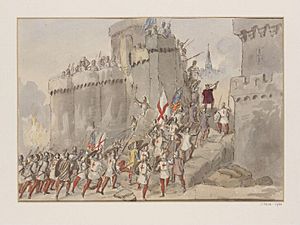Siege of Harfleur facts for kids
Quick facts for kids Siege of Harfleur |
|||||||||
|---|---|---|---|---|---|---|---|---|---|
| Part of the Hundred Years' War | |||||||||
 Modern location diagram of Harfleur |
|||||||||
|
|||||||||
| Belligerents | |||||||||
| Commanders and leaders | |||||||||
| Strength | |||||||||
| 11,300 | Garrison: 100 Reinforcements: 300 |
||||||||
| Casualties and losses | |||||||||
| Fatal: c. 2,000–5,000 Illness: c. 2,200 |
140 c. 2,000 refugees |
||||||||
The Siege of Harfleur happened from August 18 to September 22, 1415. It was a major event during the Hundred Years' War. The English army, led by King Henry V, attacked the town of Harfleur in Normandy, France.
The people defending Harfleur eventually gave up to the English. This was one of the first times the English army used powerful gunpowder cannons in a big city siege. Many English soldiers got sick or were hurt during the siege. After taking Harfleur, the English army marched towards Calais. On their way, they fought the famous Battle of Agincourt and won a huge victory against the French.
Contents
Why Did the English Attack Harfleur?
King Henry V of England wanted to invade France. He believed he had a right to be King of France. This claim came from his great-grandfather, Edward III.
Before the invasion, Henry V tried to make a deal with the French. He said he would give up his claim to the French throne. In return, he wanted France to pay a large ransom for a captured French king. He also wanted England to own lands like Aquitaine and Normandy.
The French offered a smaller dowry for Princess Catherine, whom Henry wanted to marry. They also offered a larger Aquitaine. But they did not agree to all of Henry's demands. By 1415, the talks had completely stopped.
The English Parliament then agreed to give Henry V extra money for a war. On April 19, 1415, Henry V got permission to go to war with France.
How Did the Invasion Start?
On August 13, 1415, King Henry V landed his army in France. They arrived at Chef-en-Caux, near the Seine River. His army had about 2,300 knights and 9,000 archers.
Harfleur was defended by only 100 soldiers. But two experienced knights, Sieur d'Estouteville and Sieur de Gaucourt, arrived. They brought 300 more soldiers and took charge of the town's defense.
The Siege of Harfleur
On August 18, Henry V's army began to surround Harfleur. Thomas of Lancaster, 1st Duke of Clarence, led part of the army. They set up camp on the east side of the town.
By surrounding the town, the English stopped any help from reaching Harfleur. They even captured a French convoy carrying guns, gunpowder, and arrows. The English used twelve large cannons and other siege weapons. These powerful guns badly damaged the town's walls.
After a month of fighting, Henry V planned a big attack. But the French commanders in Harfleur asked to talk. They agreed to surrender if the French army did not arrive by September 23. Harfleur officially gave up on September 22.
The English let the French knights go free if they promised to pay a ransom later. Townspeople who swore loyalty to Henry V could stay. Everyone else had to leave Harfleur.
What Happened After the Siege?
Henry V left 300 knights and 900 archers to guard Harfleur. On October 8, the rest of the English army left for Calais. Henry V hoped to find a way to cross the Somme River without being seen by the French army.
He did cross the Somme, but he could not avoid the French army. This led to the famous Battle of Agincourt.
During the siege, many English soldiers got very sick with dysentery. This illness continued to affect them even after the siege. Some historians believe Henry V lost thousands of men to disease at Harfleur. Other historians think the number was lower, but still significant.


